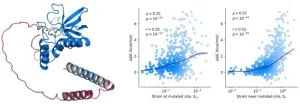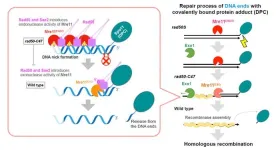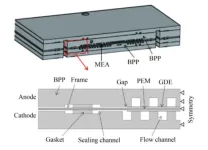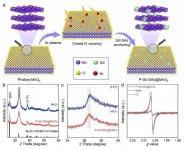(Press-News.org) AUGUSTA, Ga. (Aug. 29, 2024) – Researchers at the Medical College of Georgia at Augusta University are searching for a better way to understand why many men with prostate cancer end up with Alzheimer’s disease, and whether it’s the standard hormone therapy treatment or an overactive immune response that actually contributes to the problem.
The hormone therapy, androgen deprivation therapy, known as ADT, treats the cancer by reducing testosterone, which the cancer needs to grow. But androgen is a key regulator of amyloid metabolism and when it’s removed from the equation, more amyloid is left to form the plaques that are a hallmark of Alzheimer’s.
“We know that prostate cancer itself also largely affects men over age 65, which is a population that’s already at a higher risk of Alzheimer’s, simply due to their age,” said Qin Wang, MD/PhD, Georgia Research Alliance Eminent Scholar in Neurodegeneration and inaugural director of the Program for Alzheimer’s Therapeutic Discovery at MCG. “What is not largely understood is the role ADT may play in the context of cancer and Alzheimer’s disease.”
Wang and her research team suspected that the body’s over-active immune response and subsequent inflammation may be at play.
To better understand, they created an animal model with Alzheimer’s disease and cancer, then delivered the ADT for eight weeks, while monitoring androgen levels and tumor size. “We wanted to first validate our model and also check and see if there were cognitive deficits in that group,” Wang said.
They also developed other animal models. A so-called wild type (without Alzheimer’s or cancer), a group with just Alzheimer’s, and a group with just cancer that received ADT therapy – helped the team further delineate this complex interplay. The researchers also regularly monitored changes in the blood looking for immune markers.
At the end of eight weeks, they also looked for increased amyloid in the brain, but “to our surprise we didn’t actually see a significant difference in the plaque load in any of the groups.”
They did, however, note a high amount of reactivity in glial cells of the groups with just cancer and the groups treated with ADT. Glial cells are a part of the central nervous system and typically support nerve cells, helping them function properly. Their hyperactivity is a key indicator of inflammation in the brain, Wang said.
They also noted an increase in pro-inflammatory cytokines, small proteins that trigger an increase in inflammation throughout the body, and a decrease in anti-inflammatory cytokines, particularly in the animals with Alzheimer’s and cancer that received ADT.
The team also looked at the animals’ blood-brain barrier and noted that the same group had significant damage. Under normal circumstances, that barrier protects the brain from harmful substances while allowing essential molecules to pass through. “That would explain why there is so much more inflammation in that group,” Wang and the team reported in the journal Science Advances. “The ADT treatment is actually making the blood-brain barrier more permeable. Then these immune cells, which are circulating in higher amounts because of the cancer and the subsequent treatment, can go into the brain – we call it immune cell infiltration – and cause inflammation, which is associated with cognitive decline.”
To intervene and stop the immune cell infiltration, Wang and her team turned to a drug that is already on the market to treat multiple sclerosis and Chron’s disease. Natalizumab is a disease modifying therapy that works by attaching to immune cells and preventing them from moving across the blood-brain barrier and entering the central nervous system.
Treating the mice who had cancer and Alzheimer’s and cancer with a combination of ADT and natalizumab not only reduced the infiltration but subsequently improved the integrity of the blood-brain barrier.
“Then we looked at inflammation markers and those levels were reduced as well,” Wang said. “We essentially reduced the pro-inflammatory cycle and improved cognitive function. We now know that it’s not just about the amyloid plaques. The immune system’s response is the contributing factor here.”
Since the drug is already on the market, next steps could include a clinical trial in patients who are undergoing ADT for prostate cancer.
In addition to Wang, the research team included AU graduate student Mae Aida; Shalini Saggu, PhD, an assistant professor in the Department of Neuroscience and Regenerative Medicine; Chao Zhang, MD/PhD, who studies cancer and inflammation at the University of Alabama at Birmingham; and Lizhong Wang, MD/PhD, a professor in the Department of Genetics and the Comprehensive Cancer Center at UAB.
This work was supported with funding from the National Institute on Aging. Read the full study.
END
MCG scientists working to understand why men with prostate cancer are at higher risk of Alzheimer’s
2024-08-29
ELSE PRESS RELEASES FROM THIS DATE:
Ancient sea cow attacked by a crocodile and sharks sheds new light on prehistoric food chains
2024-08-29
A new study describing how a prehistoric sea cow was preyed upon by not one, but two different carnivores – a crocodilian and a shark – is revealing clues into both the predation patterns of ancient creatures and the wider food chain millions of years ago.
Published in the peer-reviewed Journal of Vertebrate Paleontology, the findings mark one of the few examples of a creature being preyed upon by different animals during the Early to Middle Miocene epoch (23 million to 11.6 million years ago).
Predation marks in the skull indicate that the dugongine sea cow, ...
Georgia Tech neuroscientists explore the intersection of music and memory
2024-08-29
By Jerry Grillo
The soundtrack of this story begins with a vaguely recognizable and pleasant groove. But if I stop writing and just listen for a second, the music reveals itself completely. In Freddie Hubbard’s comfortable, lilting trumpet solo over Herbie Hancock’s melodic, repetitive piano vamping, I recognize “Cantaloupe Island.” Then, with my fingers again poised at the keyboard, Freddie and Herbie fade into the background, followed by other instrumental music: captivating — but not distracting — sonic nutrition, feeding my concentration and productivity.
Somewhere, I think, Yiren Ren is studying, focused on her ...
Waging war on ‘superbugs’ in aged care
2024-08-29
There’s an urgent need for more careful antibiotic management to protect older people living in residential aged care from the dangerous spread of antibiotic resistant bacteria or ‘superbugs’, researchers from Flinders University and SAHMRI warn.
A new study published in the well-respected Journal of Infection, explores the link between the widespread use of antibiotics in residential aged care and the resulting antibiotic resistant bacteria in the gut that can be passed on to other residents.
“Commonly ...
Increasing risk of synthetic opioid drug overdoses in Australia
2024-08-29
A recent study has uncovered alarming insights into the dangers posed by fentanyl-contaminated drug supplies in Australia, including a heightened risk of lethal overdose.
The study, titled ‘The gear could be cut with fentanyl which is starting to happen more in Australia’: Exploring Overdose Survivors’ Perspectives on Toxic Supply and Safe Consumption, aimed to explore the role of synthetic opioids in overdoses among Queenslanders.
Led by Griffith University’s Dr Timothy Piatkowski, Emma Kill and Steph Reeve in partnership with the Queensland ...
Protein mutant stability can be inferred from AI-predicted structures
2024-08-29
Researchers at the Center for Algorithmic and Robotized Synthesis within the Institute for Basic Science have taken a significant step forward in understanding the stability of proteins by leveraging the power of AI. The research team used AlphaFold2 to explore how mutations affect protein stability—a crucial factor in ensuring proteins function correctly and do not cause diseases like Alzheimer's.
DeepMind’s AlphaFold algorithm, which can accurately predict a protein’s structure from ...
Shedding light on the mechanism of yeast DNA repair
2024-08-29
DNA damage is a cellular phenomenon that introduces structural abnormalities in double-stranded DNA. External factors, such as radiation or chemical agents, as well as internal factors, such as blocked DNA replication, can generate double-strand breaks (DSBs) in DNA. To counteract DNA damage, cells engage in DNA repair to preserve genetic integrity and ensure cell survival as failure to repair DSBs has serious health complications like increased risk of cancer.
DSBs are repaired by two mechanisms called non-homologous end joining (NHEJ) and homologous recombination (HR). NHEJ is the predominant DNA repair mechanism in human somatic cells and is ...
Improvement of durability of membrane electrode assembly by frame sealing structure in temperature shock
2024-08-29
Fuel cells offer a promising solution for clean energy with advantages over traditional electric power systems, including extended driving range and higher energy density. Despite these benefits, the high costs and durability concerns associated with fuel cell stacks have limited their commercialization. The durability of membrane electrode assemblies (MEAs), a key component of proton exchange membrane fuel cells (PEMFCs), is particularly affected by the frame sealing structure, which is often overlooked in research.
The study, conducted by Tiankuo Chu ...
Rare earth single atoms enhance manganese oxide's electrochemical oxygen evolution
2024-08-29
An international group of researchers has developed a novel approach that enhances the efficiency of the oxygen evolution reaction (OER), a key process in renewable energy technologies. By introducing rare earth single atoms into manganese oxide (MnO2), the group successfully modulated oxygen electronic states, leading to unprecedented improvements in OER performance.
Their findings were published in the journal Nano Energy on June 10, 2024.
Transition-metal-based oxides have been widely explored for their potential as active OER catalysts. However, the capacity of these catalysts is hindered by the adsorbate evolution mechanism, which ...
Gria: An efficient deterministic concurrency control protocol
2024-08-29
The concurrency control in deterministic databases, i.e., deterministic concurrency control, ensures that each transaction batch produces a unique result. In this way, replicas can process transactions in batches without communicating with each other to ensure consistency, which is simpler and more efficient than non-deterministic databases in achieving high availability through replication.
Early deterministic concurrency control protocols, e.g. Calvin, Bohm, PWV, rely on the prior knowledge of the read-write set, which is impractical in most scenarios. The state-of-the-art Ari breaks this limitation. However, Aria has three issues. First, ...
NSF grants $22 million for 'extreme microbe' lab collaboration
2024-08-29
The National Science Foundation has announced a $22 million grant to establish a “BioFoundry” laboratory for the study of extreme microorganisms with collaborating facilities at UC Riverside, UC Santa Barbara, and Cal Poly Pomona.
The BioFoundry for Extreme and Exceptional Fungi, Archaea, and Bacteria, or ExFAB, will focus on developing techniques to learn from nature’s more unusual microorganisms. These microbes are considered “extreme” because they have unusual nutritional requirements, grow at extremely high or low temperatures, or grow without ...







